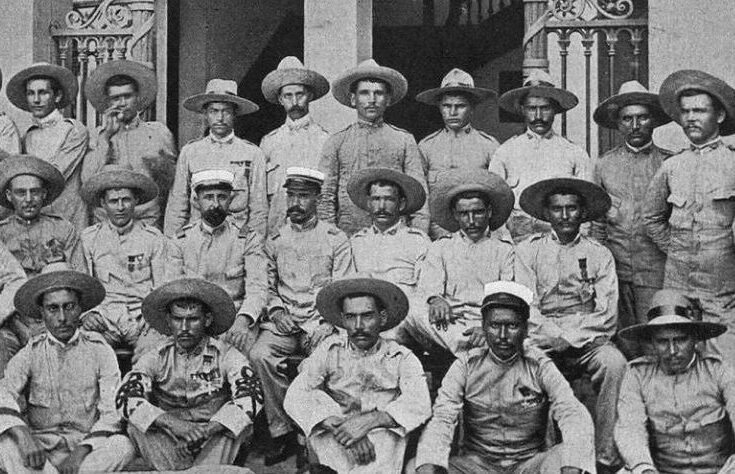Source:El Debate
He was like many veterans of Cuba and the Philippines: forgotten by all and left to his own devices. He retired as a brigadier general
When we think of the heroes of the Spanish–American War, our imagination goes back to the tiny village of Baler and the small group of Spanish soldiers who, under the command of Lieutenant Saturnino Martí Cerezo, maintained Spanish sovereignty for 337 days in a forgotten place on the island of Luzon. On 1 May 1898, the fleet of US Admiral Dewey confronted the fleet of Spanish Admiral Montojo and then bombarded and occupied the Cavite arsenal and the town of the same name.
Corporal Manuel Arrojo López was the post commander of the small detachment of nine hunters in the small town of Pilar, located inland, on the other side of Manila Bay, just opposite the capital of the archipelago.
They were quartered in the small rectory house of the village from where the Spaniards could hear and see the naval battle of Cavite.
The Spanish military command ordered the Spanish troops to concentrate in Manila but the small garrisons did not get the news and in many cases could not have obeyed it either because they were attacked by the natives who always outnumbered them, being forced to surrender or to take refuge in the most solid building in the town, usually the church, to make themselves strong, to hold out and wait for help. The small detachments scattered throughout the Philippines were cut off and left to their own devices.
Corporal Arrojo and his hunters were the only Spanish forces among a native population of over 3,000 Tagalogs. On 25 May they were surrounded with no chance of escape. Four days later the town seemed empty with the ten Spaniards barricaded in their barracks in the rectory. Suddenly an armed mob entered the town and attacked the Spanish barracks. The soldiers fought their way out through the centre of the village, opening the way with bayonets drawn in hand-to-hand combat. During this fighting, Corporal Arrojo was wounded in the side and an explosive bullet tore off his left hand. Two soldiers were killed in this skirmish and on reaching the church Arrojo was wounded again, this time in the right hand. Once inside the church, a Tagalog who had taken refuge in the church stabbed the corporal in the forehead with a machete before his men managed to eliminate him.
Besieged and without food, they soon ran out of resources and ammunition. Corporal Arrojo, despite his wounds, continued to take command of his platoon. He decided that they should climb the bell tower and, once there, destroy the stairway leading to it. From the top they saw a small column trying to come to their rescue, but it was repulsed in its advance.
Until the surrender
On 30 May, the besiegers offered them surrender, and Corporal Arrojo was lowered from the bell tower with a rope to hear their conditions. Arrojo demanded that the enemy respect the lives of the survivors and that the wounded be treated in a hospital. His conditions were accepted. For the next eight days they were confined in the same village of Pilar without receiving any kind of care. They were then taken to Cavite, the new capital of the pro-independence Tagalog forces, where the first president of the Philippines, Emilio Aguinaldo, ordered that Corporal Arrojo be given a Philippine peso in recognition of his bravery. In Cavite, they were treated by the doctors of the American squadron. Twenty days later, Corporal Arrojo and his hunters were exchanged and were able to reach Manila. Arrojo convalesced there while his men fought until the surrender of the city on 13 August 1898. The armistice had already been signed, but the Yankee commanders did not want to accept or inform the Spanish garrison, convinced that if they did not manage to take Manila they would not be able to hold on to the Philippines.
In November, Corporal Arrojo embarked for Spain, where he arrived on 15 December, entering through Barcelona and then travelling to Madrid, where he was left like many veterans of Cuba and the Philippines: forgotten by all and left to his own devices. People do not like defeated soldiers.
When the operations diary and military documentation arrived from the Philippines, General Juan Contreras Martínez, commanding general of the Corps of Invalids, was very impressed by the events that Manuel Arrojo and his men had been involved in. He proposed him for the Laurea, which was awarded to him by R.O. of 9 November 1900.
Corporal Arrojo remained in the army, as a mutilated knight, reaching the rank of colonel and retiring with the higher rank of brigadier general, as a knight laureate.
Share this article
On This Day
- 1572 Andrés Díaz Venero de Leyva founded the town of Guaduas (Colombia).
- 1578 Brunei becomes a vassal state of Spain.
- 1672 Spanish comic actor Cosme Pérez ("Juan Rana") dies.
- 1693 Painter Claudio Coello dies.
- 1702 The Marquis de la Ensenada was born.
- 1741 Spanish troops break the siege of castle San Felipe in Cartagena de Indias (Colombia).
- 1844 The Royal Order of Access to Historical Archives was promulgated.
- 1898 President Mckinley signed the Joint Resolution, an ultimatum to Spain, which would lead to the Spanish–American War.
History of Spain
26 August 2020
27 January 2021
Communism: Now and Then
23 December 2022
28 July 2021






